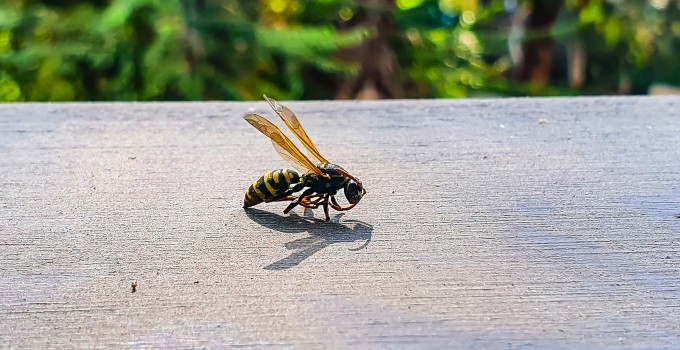
Yellow jackets are vicious pests that live in large colonies within lawns and attics all over Wichita. If you’ve ever been stung by a yellow jacket, you know how serious their presence can be. Even if you have never been stung, it’s widely known that yellow jackets are dangerous. In the summer, yellow jackets among other stinging insects like hornets and wasps become active. If you’ve found yellow jackets on your property, you probably have more questions than answers. Why are there yellow jackets in my lawn? Where do yellow jackets come from? Find out the answers to these questions and more from the pest professionals at Schendel Pest Services.
What do yellow jackets look like?
Yellow jackets are a species of wasp that’s common in Kansas and across the entire United States. Compared to other stinging insects, jackets are usually the easiest to identify because of their tiny waist and their yellow and black striped bodies. Occasionally, you’ll see yellow jackets with white or red markings along with their traditional yellow and black, but you probably won’t get close enough to truly tell.
Yellow jackets are social creatures, and their colonies return each year in late spring. Only the queen survives through the winter, and when the weather warms up, she is tasked with creating a new colony that will thrive through the summer and early fall. They aren’t destructive, so yellow jackets don’t present much danger to your home’s structure. However, if yellow jackets are nesting between your walls, some light construction may be needed to access and remove the nest.
What attracts yellow jackets to my yard?
Yellow jackets typically nest in the ground within your lawn or in attics. It’s also possible for yellow jackets to nest within wall voids if they can find a way to get inside. If you see large groups of small wasps flying in and out of the ground at the same spot, it’s probably a yellow jacket nest. They are incredibly active and will travel back and forth from the nest all day as they gather food.
Yellow jackets have a sweet tooth, and their diet consists mainly of pollen, nectar, fruit, and any sweet scraps they can find in their area. Soda, juice, and other sweets that humans enjoy can attract yellow jackets. A lot of times you’ll see yellow jackets hovering around soda cans or cut fresh fruit when you’re eating outdoors. They also gravitate towards food scraps that are in garbage cans with no secure lid. A backyard gathering is a perfect storm for yellow jacket activity. Whether you’re celebrating Independence Day, graduation, summer birthdays, or gatherings with family and friends, exposed food can bring yellow jacket activity. Towards the end of yellow jacket season in fall, they become much more aggressive and less picky. During this time they are fighting to survive, so they’ll eat pretty much anything they can find.
Do yellow jackets sting?
Yellow jackets are incredibly territorial, and they’re quick to sting anyone who comes near their nest. Yellow jackets can sting multiple times, and their stings can be quite painful. Most stings happen when you run over the nest with a lawn mower or step on the nest, not knowing it’s there. For people who are allergic to yellow jacket venom, a sting can cause serious complications like a trip to the emergency room. Even worse, you may not know that you are allergic to wasp and bee stings until you are stung and it’s too late.
If your home or lawn has been infested by these dangerous pests, it’s important that you act swiftly to remedy the problem. The professional team at Schendel is standing by to protect your home from yellow jackets and other pests, so you can focus on enjoying the beautiful summer months, not worrying about yellow jacket stings.
How can I get rid of yellow jackets on my own?
We never recommend that you try to get rid of yellow jackets with store-bought products or DIY tactics. When you use yellow jacket repellent or spray, you will be pushing the yellow jackets away from their nesting site, only to nest in another place in your home or around your lawn. This will not kill the colony or alleviate the problem. Interacting with the nest in any way is always a recipe for disaster. A lot of blogs will suggest that you pour homemade mixtures into a yellow jacket nest. This will rarely produce any results other than a whirlwind or activity and stings.
If you find a yellow jacket nest in your home or on your property, call Schendel Pest Services right away. Do not touch the nest or swat at the insects. The sooner you begin professional yellow jacket nest removal the better. Yellow jackets will not go away on their own and can even live in your walls during the winter.
How can Schendel Pest Services get rid of the yellow jackets on my property?
Yellow jackets are dangerous and should only be removed by professionals. Schendel Pest Services can get rid of yellow jacket infestations with a variety of targeted services. Our full home and full commercial property plans provide coverage against yellow jackets in addition to several other common pests. Give us a call or fill out the contact form on this page to schedule professional yellow jacket nest removal at your home or business!






